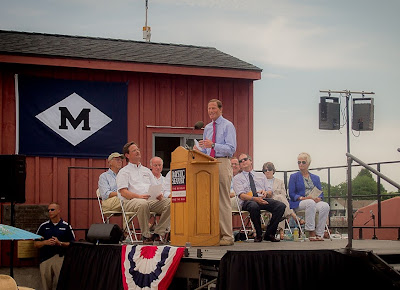Photos Courtesy Lowell's Boat Shop
Alexandria Update
Anthony is cleaning up a few details. All the frames and the inwales are installed and the interior is painted. The molds have been replaced by 3 cross-spalls to hold the shape of the boat.
With the seat risers and outwales installed, the boat has enough strength to maintain shape without the cross-spalls. The centerboard trunk is now installed. Notice one of the bolts extending through the centerboard trunk and the keel is still visible before being cut flush.
The ceiling and mast step are installed and the thwarts are being installed. Notice the notch in the centerboard trunk; a thwart will be installed there.
Work proceeds from stem to stern. All of the thwarts are in place waiting for the steam bent frames that will support them.
After harpooning a whale, the harpoon line went through the fairlead atop the stem.
View aft -- The loggerhead, mast crutch (for the lowered mast), rudder, tiller mount and aft lifting eye are in place. The loggerhead (big round thing) was used to control the harpoon line when the harpoon was in the whale. The number of wraps around the loggerhead depended on the whale. It was essentially a friction brake and a bucket of water was kept nearby to cool it when it began to smoke.
View forward – The notch to hold the harpooner’s leg, the line to support the harpooner, the forward lifting eye, the harpoon rack, and the safety fairleads are in place. The safety fairleads were safety devices that the crew hoped would catch the harpoon line if it got out of the fairlead on the stem – otherwise a loose harpoon line could crush and kill them.
Installing the mast partner. These boats were sailed and rowed. When chasing a whale, the mast was lowered. To raise the mast safely (remember they were in the middle of the ocean) the bottom of the mast was captured in the hinged mast partner and the foot of the mast was guided down into the mast step by the sloped ramp just forward of the mast step and partner. Notice the steam bent frames supporting the thwarts and the mast partner.
This is the rod used to raise and lower the centerboard. Notice the fill pieces used to level the thwarts where the crew sits. The steam bent frames that support the thwarts are on top, hence the need to level. Note the plugs glued into the countersink holes for the screws holding the leveling pieces in place. They will be cut off and sanded flush prior to painting. The wooden cleat will be installed elsewhere.
Captions and Photos courtesy Alexandria Seaport
Jack Crawford at the Alexandria Seaport Foundation recently sent me some photos of their build in progress. Jack reports they are nearly finished with their build. He adds that they have been taking their time with it, savoring it. Understandable, and laudible. Looks as though they have been doing a great job. Thanks for the update, Jack, and we'll look forward to the launch!
On the subject of launches, Graham McKay at Lowell's Boat Shop sent me photos of their launch on October 6. No captions but they're not needed, the photos are self explanatory. Looks like Graham at the helm and volunteers and apprentices providing the muscle. Lovely boat, congratulations to Lowell's! Graham says they will be building the sail rig over the winter, looking forward to the Morgan's 38th voyage.
Copyright Thomas Armstrong via Whaleboats for the CW Morgan

















































